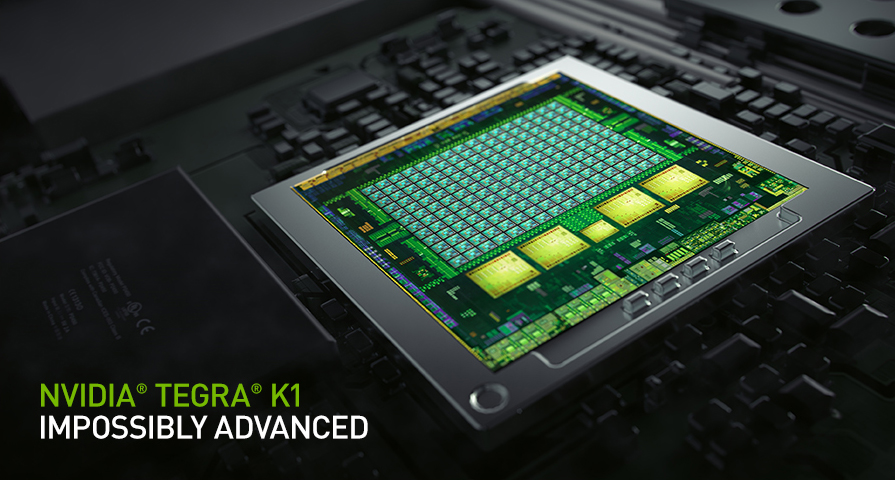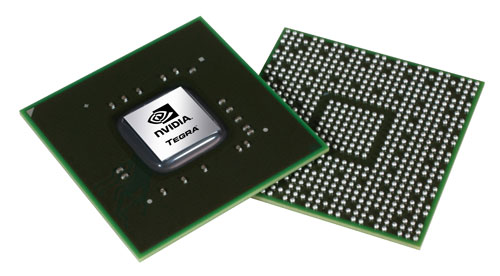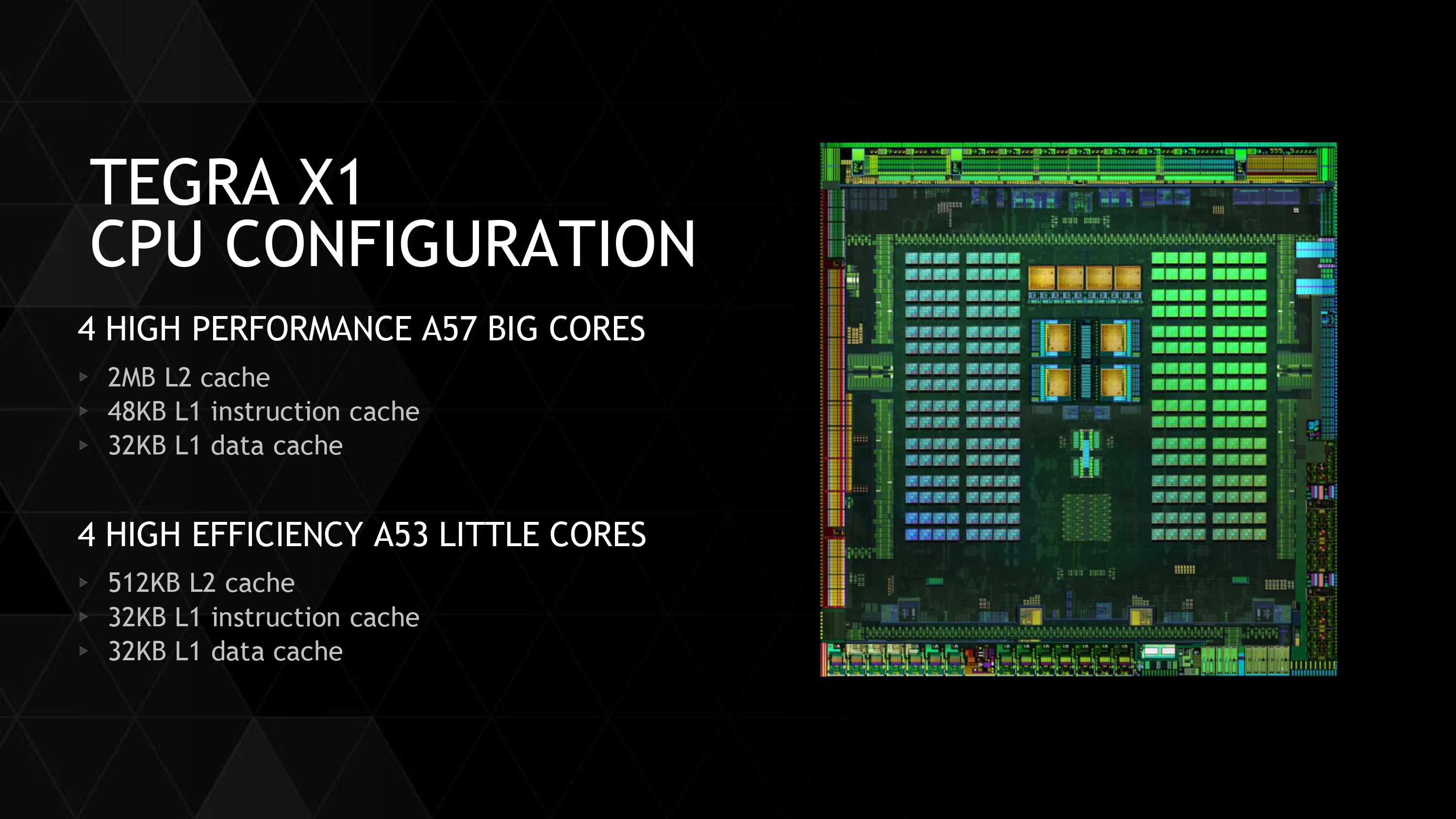Tegra
Nvidia Tegra is a system based on the ARM architecture, a single-chip system (SoC ) for mobile devices such as PDAs, mobile phones, cars, tablet PCs and multimedia player, the manufacturer Nvidia. Except for one or more ARM cores of the SoC also includes a graphics processor and integrated video decoder and encoder and fulfills all tasks of a chipset. He is among other things comparable to the Snapdragon from Qualcomm or OMAP from Texas Instruments.
- 2.1 Tegra APX Series 2.1.1 Tegra APX 2500
- 2.1.2 Tegra APX 2600
- 2.2.1 Tegra 600
- 2.2.2 Tegra 650
- 2.3.1 Tegra 2 ( T20/AP20H )
- 2.3.2 Tegra 2 3D ( T25/AP25 )
- 3.1 Embedded
Overview of the technology
APX 2500/2600
The first generation of Tegra based on a ARM11 MPCore. Manufacturing is the chip in 65 nm technology. Power consumption is according to the manufacturer's instructions at a maximum of 200 mW.
In the system, a graphics processor is integrated out of the ARM core, the processing power is comparable to the Nvidia GeForce 6 series. This allows high definition video up to 720 lines reflect both compress as well as in real-time and process photos up to 12 megapixels. As video codecs H.264, MPEG -4 and WMV9 are supported. The processor is ( so also Android ) supports both Microsoft Windows Mobile, as well as special Linux kernels.
Tegra 250
The Tegra 250 is an ARM Cortex- A9 MPCore with up to 1 GHz. The 3D performance was doubled compared to the previous models by the manufacturer. This is also used for netbooks like the Toshiba AC100. Initial tests show that the Tegra 250, depending on the operating system and test program used, can compete with Intel's Atom processors.
Specifications
Tegra APX Series
Tegra APX 2500
- Processor: ARM11 600 MHz MPCore (initially Geforce ULV) suffix: APX (originally CSX)
- Camera support with up to 12 megapixels
- LCD controller up to 1280 × 1024 pixels
Tegra APX 2600
- Improved NAND flash interface
- Video codecs: Encoding and decoding of 720p H.264 Baseline Profile and MPEG -4 simple profile D1
- Decoding 720p VC-1/WMV9 Advanced Profile
Tegra 6xx series
Tegra 600
- Application: GPS and automotive segment
- Processor: ARM11 700 MHz MPCore
- Memory: low-power DDR (DDR -333, 166 MHz)
- Outputs: SXGA, HDMI, USB, stereo audio
- HD camera 720p
Tegra 650
- Application: GTX, handhelds and notebooks
- Processor: ARM11 800MHz MPCore
- Memory: Low Power DDR ( DDR-400, 200 MHz)
- Less than 1 Watt power consumption
- HD image processing for digital cameras and camcorders functions
- Display support for 1080p at 24 fps, HDMI v1.3, WSXGA LCD and CRT, and NTSC / PAL TV output
- Support for WiFi, disk drives, keyboard, mouse, and other peripherals
- Software: Board Support Package (BSP ) for Windows Mobile - based designs
Tegra 2 series
Tegra 2 ( T20/AP20H )
- Processor: Dual -core ARM Cortex- A9 MPCore, up to 1 GHz
- 8 -core Nvidia GPU
- Graphics: GeForce ULP (Ultra Low Power). double the 3D graphics performance (10-30 % faster than the PowerVR SGX540 and 25-100 % faster than the Snapdragon Adreno 205)
- Lower Power DDR2 / DDR2 (DDR2 -667, 166 MHz)
- No support for the NEON instruction set
- Video decoding 1080p H.264 Main Profile/VC-1/MPEG-4
- Videcodierung 1080p H.264
- JPEG encoding and decoding,
- Two Screen Support
- Camera support ( up to 12 megapixels )
- Single-channel memory interface
Tegra 2 3D ( T25/AP25 )
- Processor: dual-core ARM Cortex- A9 MPCore, up to 1.2 GHz
- 3D Output
Tegra 3- Series (codenamed Kal- El)
- Processor: quad-core ARM Cortex- A9 MPCore with 1MB L2 cache and a companion core with up to 500 MHz to save power when not computationally intensive tasks.
- Ultra - low-power CPU mode
- 40 -nm process by TSMC
- Video output with up to 2560x1600 pixels
- NEON instruction set for the ARM architecture
- Decoding 1080p H.264 High Profile
- 12 - Core Nvidia GPU with support for 3D stereo
- Improved GPU (up to 3 times faster than Tegra 2)
Tegra 4 series (codenamed Wayne )
- Processor: Quad -core ARM Cortex- A15 MPCore to 1.9 GHz ( plus current parkers )
- 28nm process from TSMC
- Improved GPU (72 shaders, 10 times faster than Tegra 2)
Tegra K1 (codenamed Logan )
- Processor: 2.3 GHz clocked quad ARM Cortex- A15 MPCore R3 max. 1 GHz ARM Cortex -A15 MPCore clocked R3 low power companion core or 2.5 GHz clocked dual -core Project Denver ( ARMv8 - compatible 64 -bit Core)
- Improved with 900 MHz clocked and based on a SMX- block 192 -core GPU with new shared architecture Kepler, this GPGPU support CUDA and OpenGL 4.4. The GPU provides a computing power of 384 GFLOPS and is about 1.5 times energy efficient work ( performance per watt ) than Apple A7 and Qualcomm Snapdragon 800th
- Production at Foundry TSMC in 28nm HPM process
- Approximately 50 times faster than Tegra 2
- Appears Q2 2014 ( version with ARM Cortex- A15 MPCore R3) and 2015 ( Project Denver).
- Special version for the automotive market under the name Tegra -K1 VCM, which is used in driver assistance and infotainment systems
Use
The APX 2500 was officially launched on February 12, 2008 by Nvidia at the GSM World Congress in Barcelona. The processor is installed in mobile phones since 2009. The first media player with the chip was the Microsoft Zune HD, which has by the hardware platform high graphics performance. So the player 3D games and 720p video can play.
The Tegra 2 and 3 will be installed in various products such as smartphones, tablet PCs and single board computers since the end of 2010.
Embedded
Continue to exist for the embedded market processor modules from the following companies:
- Avionic Design Tamonten system consisting of: Evaluation board including FPGA, Tamonten NG Eval Carrier
- Tegra 2 or Tegra 3 processor modules with a focus on IO support
These modules are available for both individuals and companies individually or in combination with carrier boards and allow it to realize its own products or projects based on the Tegra processors. Thus, the Tegra 3 is, for example, in the new radio navigation systems in the new Audi A3 and VW Golf VII use.
Linux Support
Nvidia proprietary drivers for the Tegra as part of its Linux -for- Tegra development kit available. Nvidia and the Embedded Partner Avionic Design work on open- source drivers, which should be included in the Linux kernel.










